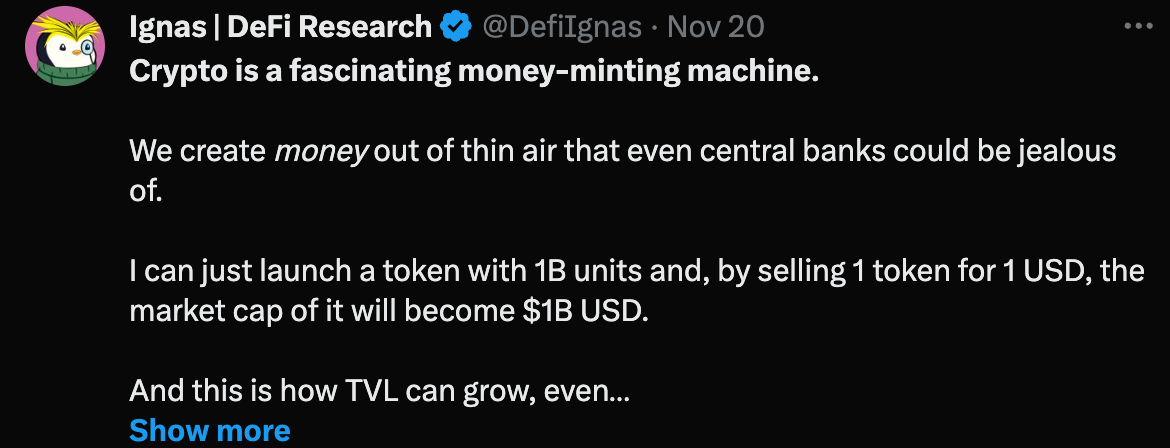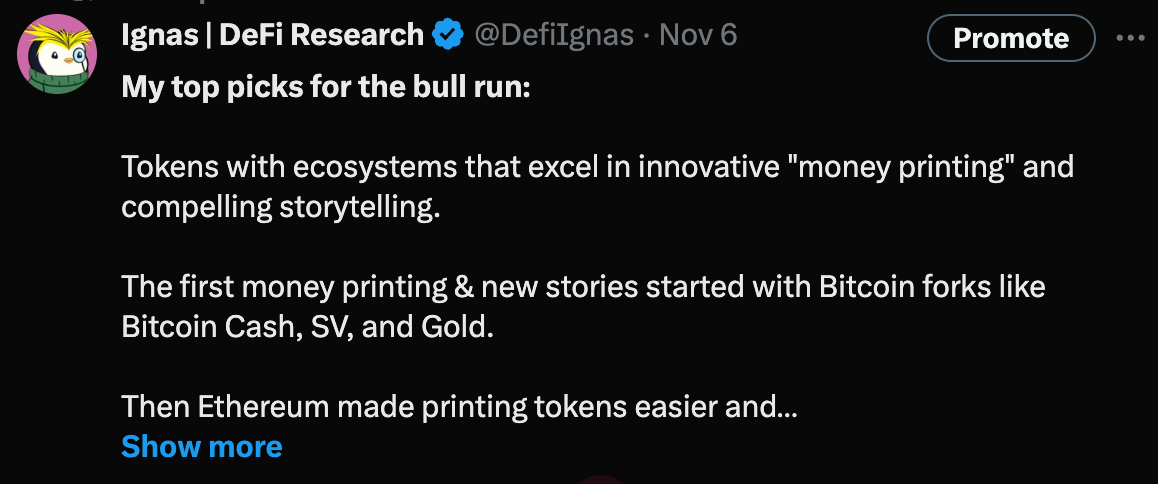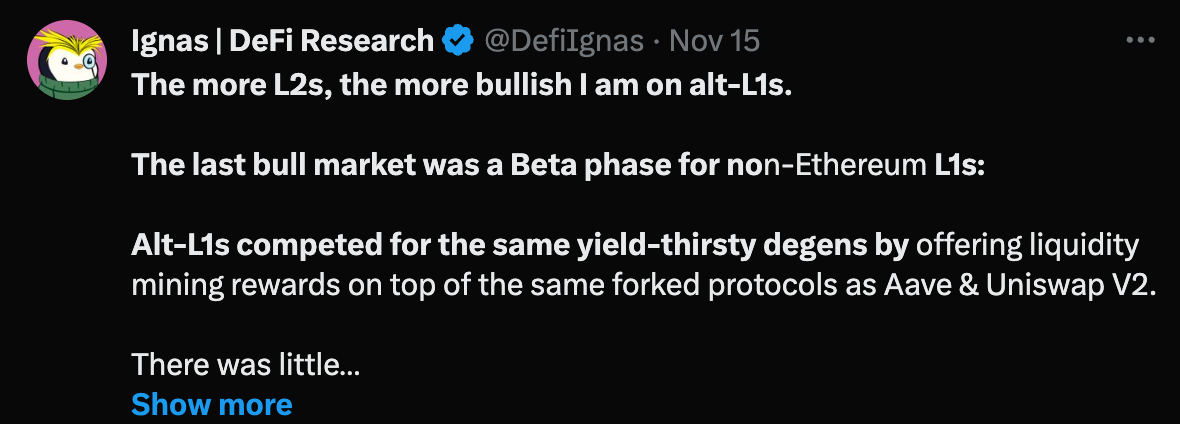How do you choose which tokens to invest in? How do you do your research? Do you simply look for alpha on X?
With so many tokens and narratives to consider, how do you evaluate which ones have the potential to outperform BTC?
In my view, the success of any crypto ecosystem is driven by three key elements: technical innovation, token minting opportunities, and captivating storytelling.
These key criteria help to evaluate the potential of a crypto project and also its ability to engage and maintain a dedicated community.
In this post, I expand and organize my thoughts on the pillars hinted at in my previous blog posts and tweets about X.
Keep learning to use AI for picture generation. Any ideas to improve my banners? lol
Additionally, I will provide current examples to support my points.
1. Technical Innovation: The Key to Progress
Technical innovation is about pushing the boundaries of what's possible. It's the driving force behind the excitement and momentum that new projects or upgrades can generate.
The more innovative the tech, the more storytelling power it has.
Bitcoin, with its distributed ledger, started it all. Then Ethereum launched enabling complex transactions with smart contracts. And I wouldn’t be wrong to say that 2017 bull market started due to the invention of ERC20s.
“However, the most significant impact of Ethereum and ERC20 was not technical; it was social. Before ERC20, coins were primarily regarded as currencies for payment or as a store of value. But with ERC20, tokenization became possible for everything. The use cases of cryptocurrency multiplied alongside the rise in crypto prices.” - My thoughts from Echoes of the Past blog post.
Last bull market was marked by emergence of DeFi, which includes multiple technical innovations: AMM, lending protocols, algo-stablecoins, etc.
Every bull market, we have new technical innovations to get excited about. Without it the industry would stagnate and ultimately fade away.
Many innovative solutions are being built during the bear runs, so staying and researching during the hard times really pays off.
Since the last bull market, new exciting technologies have emerged:
- Optimistic Rollups and ZK Rollups to reduce txs fees and increase speed on Execution layer;
- Innovation on Data Availability layer;
- Account abstraction & Intents to improve user experience;
- Soulbound tokens, non-transferable tokens to represent a person’s identity on-chain;
- Real World Assets or on-chain tokenization;
- New gen of on-chain derivatives and DEXes;
- Ordinals/Inscriptions & DeFi on BTC;
- Restaking.
AI is another technical innovation that has a big impact on crypto, even though it originated outside of the crypto ecosystem. I’m curious to see what crypto projects can really do to decentralize the AI.
However, not all technical innovations are equal if we want to earn $$$.
What sets them apart is their varying opportunities for money printing (token mining) and their potential to captivate minds and become dominant narratives.
2. Token Minting Opportunities: The Monetary Aspect
Token minting, or as I like to call it, "money printing," is akin to how central banks infuse new fiat money into an economy. In crypto, this is seen through the launch of new tokens within an ecosystem.

When Ethereum launched, the first thing we did was launch more tokens thanks to the invention of ERC20s. However, the rapid crash of 2017-18 tokens, lacking substantial technical innovation, revealed the limits of mere storytelling.
What’s more, they failed to incorporate an integrated flywheel effect that would incentivize users to hold the token through project revenue, staking, and other mechanisms.
2017-18 bull run lessons learned!
In 2020, the invention of AMM together with staking contracts was a powerful money minting machine. Staking a liquidity pool token (50% 'shitcoin', 50% ETH) to earn more 'shitcoin' was a powerful yet unsustainable Ponzi scheme that enriched early entrants. But it wasn’t sustainable.
Then Curve invented veTokenomics to offering increased rewards and voting power for longer-term staking. But the model is slowly losing support.
“Money printing” opportunities aren’t just for tokens.
NFTs exploded in 2021 with the popularity of “limited 10k” collections. Even though ERC721 innovation launched in 2017 with Cryptokitties, but the 1+1=3 crypto kitty minting model was super inflationary, and the prices crashed suddenly.
The "limited 10k" collections also had a bust as hundreds of 10k collections launched, diluting the user attention and dollar amount per collection. Bored Apes with Yuga Labs at the forefront understood the need for a flywheel effect by rewarding BAYC holders with new NFTs, tokens, and continuous storytelling to keep the community from selling.
DeFi was a profitable money minting machine thanks to airdrops & high yields.
One could get thousands of dollars for simply trying out a protocol. But airdrops are getting less generous, more complicated to get, and are more dependent on the depth of your pocket (amounts transacted, staked etc.)
While new tokens should be backed by the technical innovations mentioned, not all innovations offer equal 'money printing' opportunities.
It’s quite difficult to monetize “Account Abstraction” narrative, but Soulbound token narrative is even more complicated (the SBTs aren’t tradable!).
RWA, too, is a powerful narrative, but the inherent low volatility to RWAs might not be the best shot if you are looking for 100x opportunities.
So, where are the money printing opportunities now?
Ordinals, BRC20s & Bitcoin DeFi
Every day sees the launch of many new, often freely mintable, Bitcoin NFTs and BRC20 tokens. This narrative is made possible by the invention of transforming fungible satoshis into non-fungible ones.
But Ordinals and BRC20s lack the flywheel ponzitokenomics. I’m afraid that Bitcoin NFTs will suffer the same fate as Ethereum NFTs as dollar amount per collection and attention is diluted. BRC20s, too, lack the smart contract capabilities that make ERC20s more ponzi-friendly.
Yet, I believe things are changing. For example, Bitmap Ordinal holders received BMP token airdrop and the trend might pick up, so holding OG Ordinals might pay off.
But more is technical innovation is needed to enable flywheel tokenomics and when it does, I’ll share my Degen Playbook. So, make sure to subscribe to my blog.
Subscribe
Maybe Stacks will be able to capture this narrative and ‘tame it’ by adding Ponzi games to Bitcoin DeFi.
Layer 1 ecosystems
Seven months ago, I shared my degen’s playbook to the zkSync Era Ecosystem.
I believed that the technical innovation of ZK Tech would be powerful enough to attract devs and new money into the ecosystem, thus pumping the tokens. However, this didn't play out.
It turns out, the ZK Tech narrative wasn't captivating enough. There's also a lack of innovative dApps as well as a lack of flywheel token minting opportunities. The airdrop farming narrative has subsided since then and wasn't strong enough to keep up the hype.

Now, there are a few promising L1s:
- Injective offers money printing opportunities to INJ token stakers. Ecosystem is new so money & user attention is focused on a few protocols and NFTs so far.
- Kuji is similar to Injective, but it emphasizes the flywheel effect within the ecosystem project airdrops as well as real yield potential with no new KUJI token emission.
- Solana ecosystem has been wiped out, but it is rebuilding. New tokens are being launched with airdrops to loyal ecosystem users. Solana is also dominating the Modular blockchain narrative.
- Avalanche is becoming the RWA and Forex chain, which is a more sustainable growth model.
- Polygon’s POL is transforming into the chain of chains with new partnerships choosing to Polygon to scale Ethereum with (hopefully) value flowing back to POL.
- Fantom like Solana lost most of its DeFi ecosystem. But with Sonic upgrade it is targeting Modular blockchain narrative.
- Celestia is dominating Data Availability narrative but more chains need to launch and reward $TIA token stakers.
- SEI is a lower-cap competitor for SUI and APTOS, but as a new ecosystem, I expect them to reward SEI token stakers as the ecosystem expands. Might have a “hated L1” rally.
Where are L2s?!
I’m more bullish on L1s in terms of tokenomics. L1 tokens have native staking yield and ecosystem airdrops to stakers. So, L2 tokens could become more appealing if they were used for gas fees, staking, and if ecosystem tokens were airdropped to L2 token holders/stakers.

The recent vote by Arbitrum DAO, involving fake "staking," shows the uselessness of L2 tokenomics.
3. Storytelling: The Power of Narratives
The power of storytelling in crypto is crazy! Narratives play an enormous role in explaining why tokens pump.
Technical innovations are great, but their success often depends on how well they are communicated and understood by the community. A complicated narrative can lead to disinterest, no matter how significant the innovation.
Storytelling is what gives life to the technical aspects and tokenomic models, turning them into something people can relate to, believe in, and become a part of. It captures the imagination and belief of people, creating a strong, engaged community.
Narrative is essential in sustaining the value and demand for newly minted tokens. Without compelling narratives and a belief in the potential of these tokens, there would be little to no incentive for new users to join and invest in the ecosystem.
Narratives alone can pump tokens, but with substantial technical innovation and token minting opportunities, tokens can sustain high prices for longer. Without other too elements tokens can dump as fast as they rise (Hamster token, anyone?)
DeFi, for example, has all three key pillars. It flourishes on the technical innovation of smart contracts and self-custody, allows for innovative token value creation, but also has a powerful narrative of creating a new type of financial system.
Terra's UST is a notorious example, but it nailed the three pillars too with algo-stablecoin technical "innovation", money flywheel effect (Ponzi), and a story of passive income with 20% APY.
So, what are the narratives that match the three pillars for a booming ecosystem?
Restaking + LRTs, which sell the "Secured by Ethereum" story, is one. DeFi on Bitcoin is another one although its value ‘taming’ mechanism to prevent over-inflation are weak.
Modular vs Monolithic L1s is a mega story of this bull run, with Solana, SEI V2 and Fantom challenging the modular vision of Ethereum, Avalanche and Polygon. Which approach will succeed? Not easy to answer, but both approaches will probably have a place in crypto.
AI is a powerful narrative, but technical innovation for AI is currently minimal and token minting opportunities are low. Yet, as I mentioned, AI tokens will and are pumping, but without real innovation and flywheel effect they can dump as fast as they pumped.
Question to you: What are the ecosystems that satisfy all three criteria? Please let me know in the comments!
The Difference Between ‘Booming’ & ‘Flourishing’ Ecosystems
I initially named this blog post “Three Pillars of Flourishing Crypto Ecosystems”, but it’s not precise.
The three pillars help the ecosystem boom, but it comes a time when innovation slows down as new competitors emerge, the new money minted within the ecosystem exceed the attention and dollar amount entering the ecosystem to sustain prices, and narratives get replaced by hotter plays on CT.
Axie Infinity is a good example of a "boomed" ecosystem. Games on the blockchain were a novelty, and Axie nailed selling the Play-to-Earn vision to the world.
Thousands of Filipino people believed they could earn from playing the game. Yet, its growth depended on new people coming into the ecosystem as more and more NFTs and Smooth Love Potion tokens were minted.
In crypto, we are continuously playing this similar game. New innovations and narratives get monetized with new tokens issued. Unless the ecosystem manages to keep innovating and reinventing itself, and token inflation is managed, the once booming ecosystem deflates.
DeFi has “boomed” with liquidity mining, but we keep on reinventing it. DeFi 1.0 projects have passed the initial hype stage and are finally entering sustainable growth stage.
But the narratives I mentioned in this post are yet to boom. Their ecosystems are young with new exciting tokens to launch. Our task is to find ecosystems that build the most sustainable ecosystems.
It's a delicate balance where each element reinforces the others, creating an environment for growth and sustainability. As we continue to see the developments in this bull run, I believe that these three pillars will help you to find thriving ecosystems from the fading ones.














